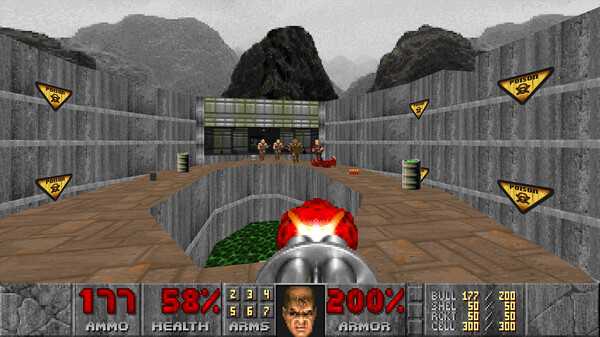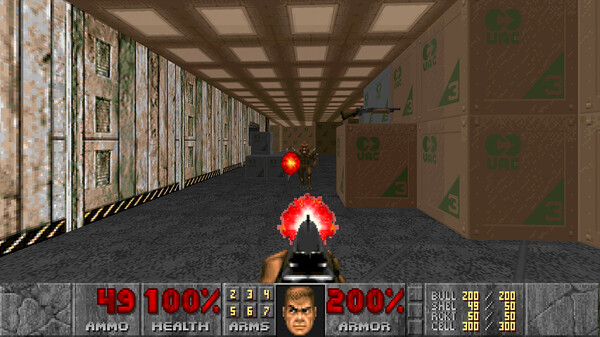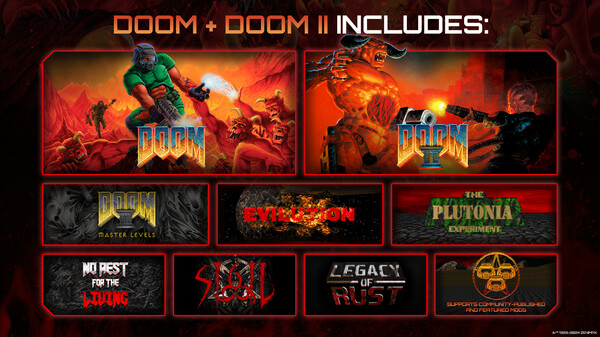A Classic DOOM Review For First-time Players I'll start off by saying that if you already love classic DOOM and you're looking to hear about the quality of the port: it's great. It comes with every official classic DOOM game/expansion that was ever released, it has lots of difficulty/control customization options, and it has built-in mod support. But I'm not here to talk about that. Instead, this review is for people like myself, who have never played classic DOOM before and were introduced to the series through DOOM 2016/Eternal, or possibly even another shooter of the same nature like ULTRAKILL. If you're coming into this game expecting a similar experience to those games, then you're most likely going to be disappointed. Classic DOOM has a significantly different gameplay philosophy, and it took me far too long to realize that. My Experience I've tried getting into classic DOOM two times prior to this: The first time was in early 2020 leading up to the release of DOOM Eternal, where I did a playthrough of both DOOM 1 and DOOM 2. I treated them like straightforward run and gun games; the same way I treated DOOM 2016. I sped through levels, mindlessly shooting whatever was in my way with no regard to how the levels were designed and no attempt to explore them. This led to many frustrating moments where I would run out of ammo completely, and question why ammo was so limited in a fast paced action FPS. I came out of it thinking the games were okay, but struggled to understand why they're so critically acclaimed aside from their massive impact on the genre. The second time was in 2023, where I took a completely different approach to my playthrough in 2020. I explored each level as thoroughly as possible, hell bent on getting 100% kills and secrets. This resulted in the opposite issue: I was entering levels with an overabundance of health and ammo. This turned the game into the straightforward run and gun game that I was treating it as in 2020, except the simplicity of the combat made it feel uninteresting and repetitive. None of my exploration felt rewarding because it was unnecessary. I dropped DOOM 1 less than halfway through the game out of boredom, and dismissed classic DOOM as a primitive relic of the past that doesn't hold up compared to modern DOOM and similar releases. This is no longer the case. Over the past month I've played through DOOM 1, DOOM 2, and The Plutonia Experiment, which has changed my perspective on the series completely. I want to explain what makes classic DOOM fun, because it's not as obvious as you might expect. What Makes Classic DOOM Fun First, I have an important recommendation. If my description of classic DOOM as run and gun games with simple combat doesn't bother you, then you're free to ignore this recommendation and disregard this review. But if you're looking for more than that and you want to experience this game at its best, then I strongly recommend you listen to what I'm about to say: pistol start every level. If you aren't already familiar, pistol starting means that you'll enter every level the same way that you enter the first level: 100% health, 0% armor, and nothing but a pistol with 50 bullets. When you select your difficulty, if you press tab then you'll be given the option to pistol start all levels. Levels are inherently designed around pistol start and frequently contain weapon pickups. The rest of this review will be written with pistol starting in mind, in which I'll also explain in more detail why I'm recommending it. Let me get this out of the way: classic DOOM is not an action game in the same way that modern DOOM is. Modern DOOM games are full blown action games that encourage you to be hyper aggressive: in both DOOM 2016 and DOOM Eternal, you have several means of regaining resources mid-fight, and it allows you to take on any fight in an extremely head on manner. Classic DOOM on the other hand feels more like a hybrid of action and survival. Hitscanners capable of shredding your health make up a good portion of the enemies you'll be fighting, and you're going to be gaining health and ammo primarily through pickups scattered around levels. There will be moments where you're too low on health or ammo to be aggressive, and overcoming those moments is where classic DOOM shines. Oftentimes you'll be in situations where you're running around a level like a madman, searching for a weapon or ammo while avoiding enemies that are actively pursuing you. Nothing beats moments where you're in a situation like that, and you come across a desperately needed shotgun pickup or a box of shells that enables you to properly fight back. This is why pistol starting levels is so important, as not pistol starting (mostly) strips you of these moments. When you're pistol starting each level, finding a weapon pickup feels so much more satisfying, and exploration/hunting for secrets becomes extremely rewarding. As you die during a level (which you likely will during more challenging levels), you'll become more aware of the level layout, and be able to plan your route in a way that lets you rebuild your arsenal more quickly and efficiently. These games have made me do more pre-planning than I think I ever have in a shooter before. Creativity is heavily rewarded as well; there's no objectively correct way to approach a level, it's up to you through trial and error to figure out an approach that works for you. You can immediately dart towards a rocket launcher or plasma gun pickup on the other side of the map, strafing around enemies in your way then dealing with them after you grab it, you can pinpoint and save an invincibility powerup then use it to breeze through a difficult fight that you know is coming up, or you can run circles around enemies and get them to accidentally attack each other then start infighting, saving yourself ammo. Tons of possibilities. Essentially, what I'm saying is that level design is a huge component in what makes classic DOOM fun. While the combat itself is simple, the way levels are designed require a very thoughtful approach, and make for a super unique and engaging experience. Of course this experience varies depending on each level, as some are more well designed than others, but you definitely feel it when you're playing a good level. If you want to aggressively run through levels while shooting everything on sight, then these might not be the right games for you, and that's okay because plenty of other games fill that niche. But if what I've been describing sounds interesting to you, then these games will definitely be worth your time. Additional Points I'd love to talk more about the positives of these games, but I'm running out of space in this review and I'd mostly be repeating stuff you could hear anywhere else. Yes the enemies are phenomenal, yes the arsenal is solid, and yes the music is great (I love the Andrew Hulshult remixes). Not everything is perfect; some levels make it too easy to avoid enemies or bait them out and slowly kill them near cover, the quality of levels can vary dramatically, the berserk powerup is very poorly communicated (seriously, I'd recommend looking up how it works), and there's some occasional frustrating jank due to technical limitations. But even with these issues in mind, the core of what makes classic DOOM fun still stands. I think I'll always prefer the more aggressive combat of modern DOOM, or the verticality of Quake, but classic DOOM provides an incredibly unique experience that no other FPS I've played has provided. Dismissing it as primitive and dated is one of the biggest gaming sins that I've ever committed, and I hate that it took me three attempts to get it. But I'm so glad that I finally do.
Expand the review































